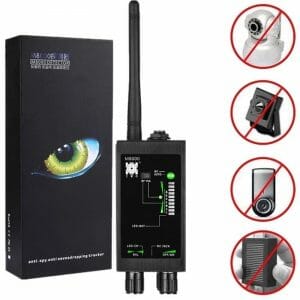An RF (radio frequency) detector is a device to locate and identify sources of radio frequency signals. These signals can come from various sources, including cell phones, radios, and wi-fi routers. Law enforcement, the military, and other government agencies commonly use RF detectors to locate and track electronic devices and individuals who want to detect and block unwanted signals.
RF detectors can be handheld or portable, and they typically have a range of frequencies they can detect. Some RF detectors are also equipped with additional features, such as detecting hidden cameras or blocking incoming signals.
Many types of RF detectors are available on the market, ranging from simple and affordable models to more advanced and expensive ones. It’s important to consider the features and capabilities of different RF detectors.
Check out the best bug detector list we compiled for you!
What is an RF Detector?
Many spy devices with microphones or cameras invade people’s privacy. Some of these devices can be found in the form of the following:
- Small appliances that are difficult to detect
- Pens
- Alarm clocks
- Clothing buttons
- Battery chargers
- Decorative objects
- Teddy bears
How does an RF detector work?

When someone turns on this device, there is a signal display with LED lights. It can be supplemented with an audible alert to provide a more accurate operation. The visual or audible signal intensifies or weakens as the user moves closer to or further away from a device emitting RF signals.
Professionals using an RF detector need most wireless network devices to be turned off. The leading wireless networks that can provide a false signal on the RF detector device are as follows.
- Devices with wi-fi networks
- Devices with Bluetooth turned on (1)
- Cordless phones with a call
- Cell phone wireless networks
What Exactly Are Radio Frequency Signals that Can Be Detected?
Radiofrequency (RF) signals are electromagnetic waves that are used to transmit information wirelessly over long distances. They are a type of non-ionizing radiation, which means that they do not have enough energy to ionize atoms or molecules and cause damage to living tissue.
RF signals are used for various purposes, including communication, navigation, and data transmission. Examples of devices that use RF signals include cell phones, radios, televisions, Wi-Fi routers, and satellite systems.
RF signals are typically transmitted and received using antennas, specialized devices designed to transmit or receive electromagnetic waves. The frequency of an RF signal refers to the number of times the signal oscillates or cycles per second, measured in hertz (Hz). The higher the frequency of an RF signal, the shorter its wavelength and the more data it can carry.
Where can an RF detector be used?

An RF detector can be used in various places within a home, in a vehicle, or even in a hotel. A radio frequency detector should be used in all those areas suspected of having a spy device. (2)
You should know that a spy device is usually a tiny and subtle object. The number of places to implant a spy device is too broad to name here.
Having your own RF detector in all suspicious places in your home is best. An RF detector works better as it gets closer and closer to the spy camera. This tool can be used anywhere.
Wrapping Up
An RF detector is a tool used to detect and control devices that generate radio frequency. This tool is very much in demand for finding spy devices that harm people’s privacy.
If you have any comments, you can leave them below and share the article if you like it. An RF detector is a must when people believe they are being spied on in their homes or vehicle. Knowing how to use it is necessary to understand exactly what this tool is about.
After knowing what an RF detector is, you may check this learning guide on using a bug detector. And if you feel like making your own, here’s our guide on how to make a bug detector. Until next time!
References
(1) Devices with Bluetooth – https://www.techwalla.com/articles/the-different-types-of-bluetooth
(2) frequency – https://www.britannica.com/science/frequency-physics

